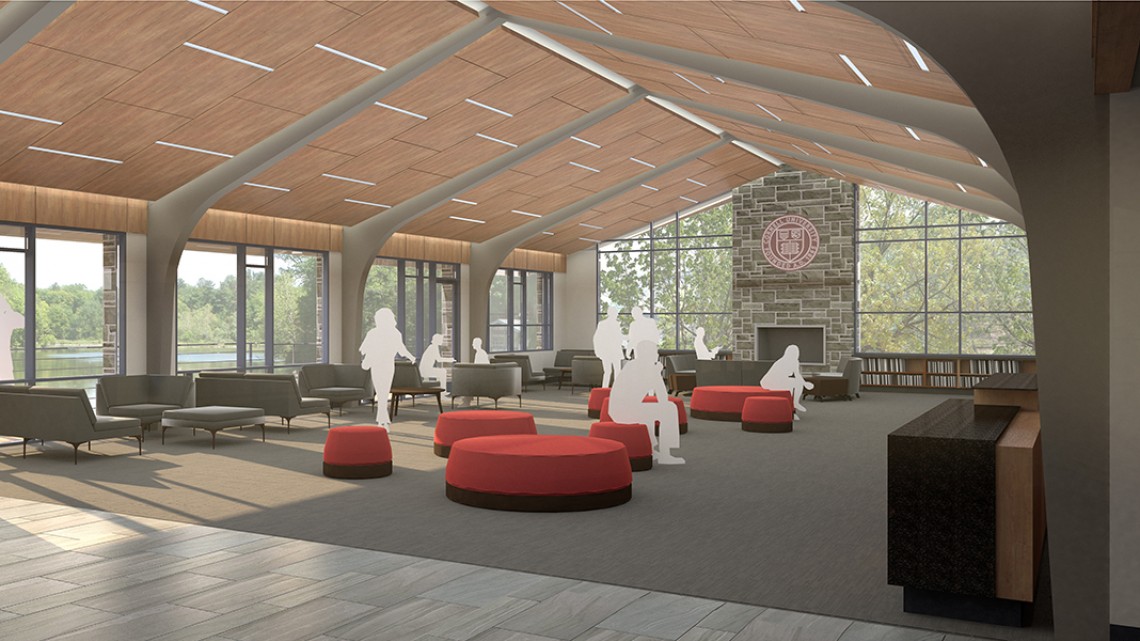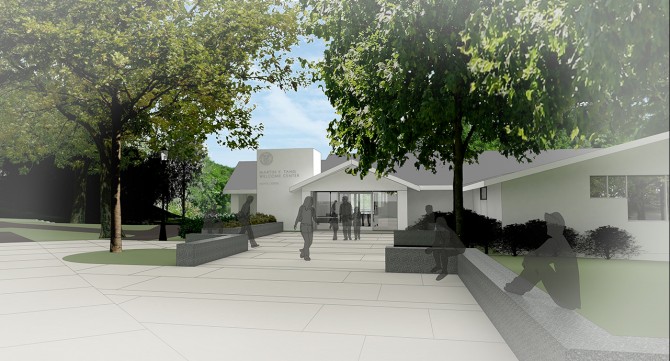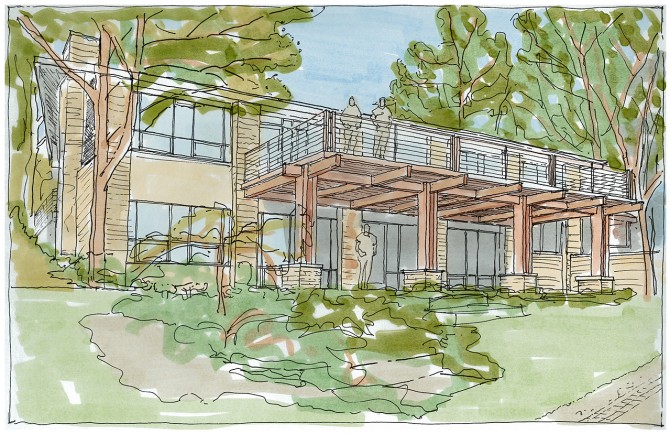
The Great Room on the Martin Y. Tang Welcome Center's upper level will accommodate large groups visiting for tours.
Tang Welcome Center will be ‘wonderful gateway to Cornell’
By Daniel Aloi
The Martin Y. Tang Welcome Center, opening next month in the renovated and repurposed Noyes Lodge on North Campus, will be the first stop at Cornell for prospective students, parents and thousands of other visitors each year.
Named for longtime Cornell benefactor and Trustee Emeritus Martin Y. Tang ’70, the center will be the starting point for student-led campus tours and an information hub for visitors.
With its sweeping views of Beebe Lake, the wood-and-stone building maintains its “Finger Lakes lodge feel,” according to Taiya Luce, director of visitor relations.
Interior modifications include the Great Room, a space on the upper level for visitors to gather; and a new exhibition space with displays highlighting the university’s history and mission.
The Great Room opens onto the Treman Terrace, a new 840-square-foot wooden deck at the rear of the building that overlooks Beebe Lake and the western portion of Cornell Botanic Gardens, and the foot bridge, dam and spillway above Triphammer Falls.
A small plaza on Thurston Avenue will feature signage for the new center, an accessible walkway leading to the building entrance, landscaping and bluestone benches.
The building also contains five restrooms, a reception area, space for the Office of Visitor Relations on the lower level, a conference room, a break room for students on staff, and the general information switchboard for the university (607-254-4636).
Beginning June 1, the welcome center will be open Monday through Friday from 8 a.m. to 6 p.m., and most Saturdays from 8 a.m. to 3 p.m. The switchboard operates Monday through Friday from 8 a.m. to 8 p.m.
The welcome center project was designed and overseen by JMZ Architects and Planners of Glens Falls, New York. The New York City firm Herter Design Group designed the exhibit space.
Display cases will feature items representing Cornell athletics, inventions, collections and history, and a selection of books by Cornell authors. Reader rails, wall displays and monoliths will bear informative text, photographs and story panels on a variety of Cornell impacts and experiences, history and traditions.
Objects in the exhibit will include Big Red hockey gear, Rover Athena from the Cornell Mars Rover Project, wearable tech created at Cornell, Rich Medina ’92’s DJ equipment from the Cornell Hip Hop Collection, and a 3D-printed replica of Ezra Cornell’s telegraph (the original was on display in Kroch Library for Cornell’s sesquicentennial in 2015).
“The array of artifacts on display represent the contributions of a wide array of Cornellians, from our visionary founders to today’s tech-savvy students, innovative faculty and inventive alumni,” said Joel Malina, vice president for university relations. “The displays really give you a taste of the amazing things that happen here at Cornell.”
More than 20,000 prospective students and family members visit the university each year. Luce noted that visitors also include those on bus and walking tours, international tourists, children in summer camps, new faculty and local residents.
“First impressions are incredibly important and the Martin Y. Tang Welcome Center will serve as a wonderful gateway to Cornell for prospective students and families,” said Jason C. Locke, interim vice provost for enrollment. “It will be a tremendous asset in our efforts to recruit the best undergraduates from around the globe.”
Campus tours with trained student information specialists, which last about an hour, will start at the welcome center and end at Ho Plaza on central campus. Visitors can tailor their Cornell experience with the Plan Your Visit tool, an online resource with campus destinations, an itinerary builder and information on scheduling a tour.
“The tool is instrumental in helping us to communicate with visitors and to help them know what to expect,” Luce said.
The $6 million project was made possible by a $3 million gift in 2016 from Martin Tang and his sisters, Nadine Tang and Leslie Tang Schilling, in response to a challenge grant for the same amount from The Atlantic Philanthropies, the foundation created by Charles Feeney ’56.
Martin Tang has supported many areas at Cornell including international scholarships, the College of Agriculture and Life Sciences, Cornell Botanic Gardens and Student and Campus Life.
Members of the Treman family – including Laura Treman Almquist ’56 and John Almquist ’54, Terese Treman Williams and Joseph Williams, and Carol Treman des Cognets ’60 – also provided support for the project.
Built in 1958, Noyes Lodge was originally a dining hall and is remembered as home to the Pancake House and the Pick-Up, a small grocery, in the 1970s and ’80s. Until recently the lodge housed the Language Resource Center (LRC); the welcome center project included renovations to accommodate LRC’s move to Stimson Hall.
Media Contact
Get Cornell news delivered right to your inbox.
Subscribe


